Market Overview
The Global Alkyl Polyglucosides Market size is projected to reach USD 1.3 billion in 2025 and grow at compound annual growth rate of 7.5% from there until 2034 to reach a value of USD 2.5 billion.
Alkyl Polyglucosides (APGs) are a type of surfactant made from natural sources like sugar and fatty alcohols. They are widely used in cleaning and personal care products because they are gentle on the skin and safe for the environment. These surfactants do not produce harmful by-products and are easily biodegradable, which makes them a preferred choice in eco-friendly formulations. APGs are non-ionic, meaning they do not carry a charge, which makes them stable and compatible with other ingredients in various formulations.
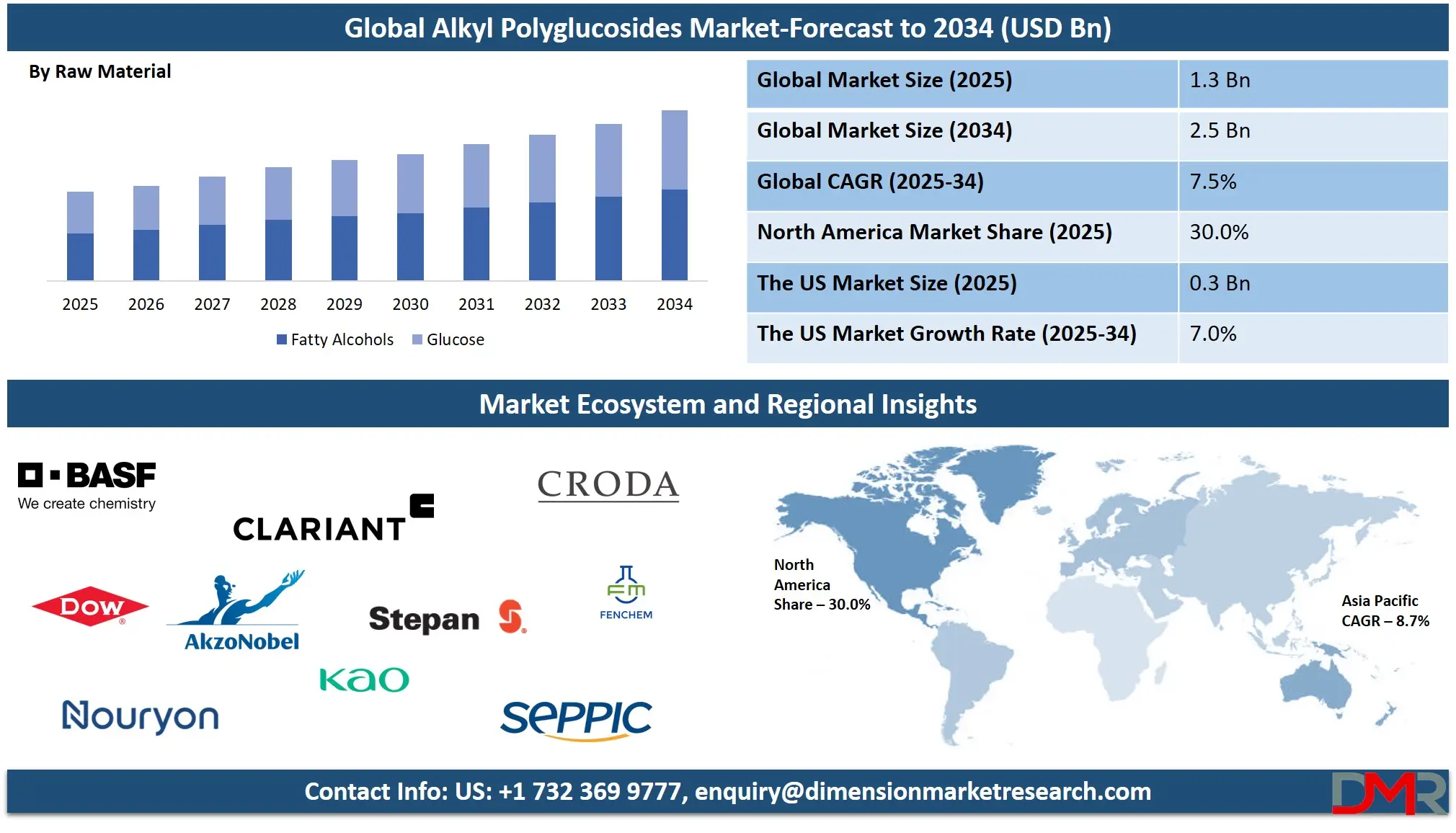
In recent years, the demand for Alkyl Polyglucosides has grown steadily due to the shift toward greener products in both personal and industrial use. Consumers are looking for products with fewer synthetic chemicals, and industries are responding by using more plant-based, biodegradable materials &
biodegradable plastic. APGs meet this demand because they are naturally derived and perform well in a wide range of applications such as shampoos, dishwashing liquids, laundry detergents, and hard surface cleaners. This shift is being seen globally, not just in advanced markets, but also in developing regions where awareness about sustainability is rising.
Several trends are shaping the growth of the APG market. There is a noticeable increase in the use of sulfate-free and mild cleansing products in personal care. APGs are often chosen for these products because they are known to be gentle and effective. Another trend is the blending of APGs with other surfactants to enhance foam, cleaning power, or texture. These blends are helping companies offer high-performing products while maintaining their commitment to natural and safe ingredients.
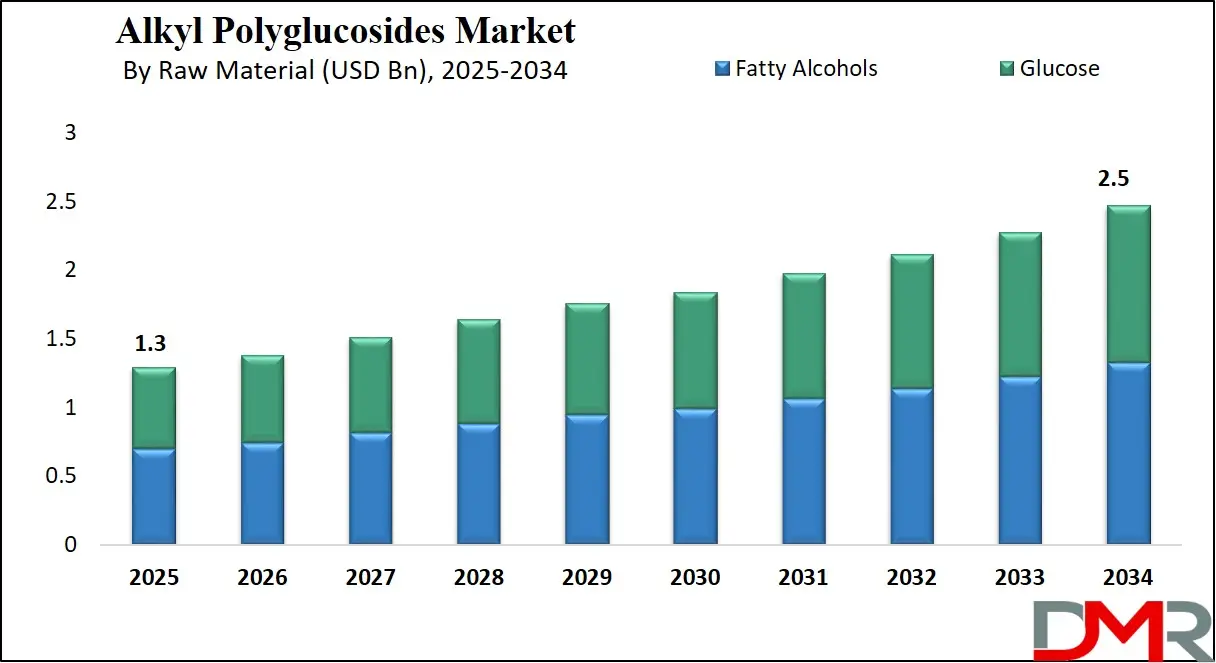
Important events in the past few years include the introduction of new APG-based product lines by many companies. Research and innovation in green chemistry have also led to improved production methods for APGs, making them more efficient and cost-effective. Governments and environmental groups have also increased their support for the use of safe and natural surfactants, encouraging their adoption in various sectors. These developments have supported stronger growth and wider acceptance of APGs across the industry.
Another key insight is the expansion of APGs into industrial and agricultural sectors. In agriculture, they are used as adjuvants to help pesticides spread more effectively. In industrial cleaning, APGs are used in safer formulations for surfaces and equipment. Their mild nature and strong performance make them a good fit in areas where safety and environmental impact are important. This wider application range is opening up more growth opportunities beyond traditional home and personal care markets.
The US Alkyl Polyglucosides Market
The US Alkyl Polyglucosides Market size is projected to reach USD 300 million in 2025 at a compound annual growth rate of 7.0% over its forecast period.
The US plays a key role in the Alkyl Polyglucosides market due to its strong focus on sustainable and green chemistry practices. With increasing consumer demand for eco-friendly and non-toxic products, US-based manufacturers and brands are actively incorporating APGs into personal care, household cleaning, and industrial applications.
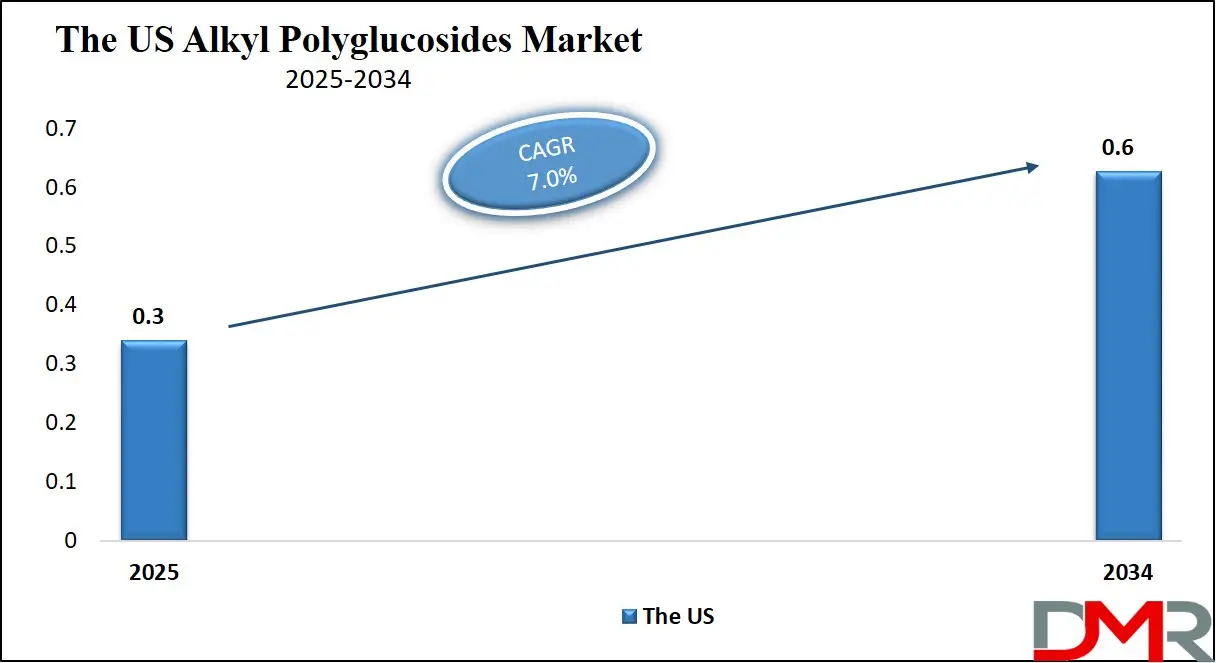
The country also leads in regulatory support for safer chemicals, encouraging innovation and investment in bio-based surfactants. In addition, the presence of major chemical companies, research institutions, and advanced manufacturing infrastructure helps the US remain a major contributor to market development. The US market also influences global trends through exports, collaborations, and the setting of clean-label and performance standards that guide product development in other regions.
Europe Alkyl Polyglucosides Market
Europe Alkyl Polyglucosides Market size is projected to reach USD 325 million in 2025 at a compound annual growth rate of 7.2% over its forecast period.
Europe holds a significant role in the Alkyl Polyglucosides market due to its strong environmental regulations and consumer preference for sustainable products. The region has been at the forefront of promoting biodegradable and non-toxic ingredients in personal care, household, and industrial products. European policies such as REACH and the Green Deal encourage the use of safer chemicals, driving manufacturers to adopt APGs.
Additionally, European consumers are highly aware of product labels and demand transparency, pushing companies to use natural surfactants like APGs in formulations. Innovation in green chemistry is also strong in Europe, with active research and development focused on improving APG performance. This commitment to sustainability positions Europe as both a leader in usage and a trendsetter in the global APG market.
Japan Alkyl Polyglucosides Market
Japan Alkyl Polyglucosides Market size is projected to reach USD 65 million in 2025 at a compound annual growth rate of 7.0% over its forecast period.
Japan plays a pivotal role in the Alkyl Polyglucosides (APG) market across East Asia and globally. Over recent years, its APG market has steadily grown, driven by increasing environmental awareness, stricter chemicals regulations, and rising consumer demand for green products. Domestic manufacturers have heavily invested in advanced production technologies, including biobased feedstocks and optimized processes, enabling more cost-effective and high-quality APG output.
Demand spans multiple sectors—household cleaners, personal care, and industrial uses—with strong uptake in residential applications like shampoos, detergents, and surface cleaners. While the domestic market continues to expand, pricing competitiveness driven by local innovation and regulatory support ensures Japan remains a major contributor to regional supply chains. Its emphasis on sustainability and clean-label trends makes Japan a trendsetter in Asia for APG adoption.
Alkyl Polyglucosides Market: Key Takeaways
- Market Growth: The Alkyl Polyglucosides Market size is expected to grow by USD 1.1 billion, at a CAGR of 7.5%, during the forecasted period of 2026 to 2034.
- By Raw Material: The Fatty Alcohols are anticipated to get the majority share of the Alkyl Polyglucosides Market in 2025.
- By Application: The home care product segment is expected to get the largest revenue share in 2025 in the Alkyl Polyglucosides Market.
- Regional Insight: Asia Pacific is expected to hold a 35.8% share of revenue in the Global Alkyl Polyglucosides Market in 2025.
- Use Cases: Some of the use cases of Alkyl Polyglucosides include household cleaners, personal care products, and more.
Alkyl Polyglucosides Market: Use Cases
- Personal Care Products: Alkyl Polyglucosides are used in shampoos, face washes, and body cleansers due to their mild, non-irritating nature. They help create foam and remove dirt without drying out the skin. Their natural origin also makes them suitable for sensitive skin and baby care products.
- Household Cleaners: APGs are popular in dishwashing liquids, laundry detergents, and multi-surface cleaners. They effectively break down grease and grime while being gentle on hands and surfaces. Their biodegradable nature supports eco-friendly cleaning solutions for modern households.
- Industrial and Institutional Cleaners: Used in industrial degreasers and hard surface cleaners, APGs provide strong cleaning power with low toxicity. They help reduce environmental impact in large-scale cleaning operations. Their compatibility with other ingredients makes them versatile in various formulations.
- Agricultural Applications: APGs act as adjuvants in pesticide formulations, improving spray spread and absorption on plant surfaces. They help reduce the amount of active chemicals needed by enhancing efficiency. Their low toxicity also makes them safer for crops, farmers, and the environment.
Market Dynamic
Driving Factors in the Alkyl Polyglucosides Market
Rising Demand for Eco-Friendly and Biodegradable Surfactants
One of the major growth drivers for the Alkyl Polyglucosides market is the global shift toward environmentally friendly and sustainable products. Consumers and industries alike are becoming more conscious of the environmental impact of traditional chemical ingredients used in cleaning and personal care products. APGs, being derived from renewable resources like plant-based sugars and fatty alcohols, are naturally biodegradable and non-toxic.
This makes them a preferred alternative to synthetic and petroleum-based surfactants. Governments and regulatory bodies in many regions are also enforcing stricter rules on chemical safety and environmental protection, further pushing manufacturers to adopt greener ingredients. The clean-label movement in consumer goods has made APGs more attractive in product formulations. As sustainability becomes central to business strategies, APGs are expected to see continued demand across multiple sectors.
Expanding Applications Across Diverse Industries
The versatility of Alkyl Polyglucosides is another key factor fueling market growth. Initially used mainly in household cleaning and personal care products, APGs are now gaining traction in a wide range of applications such as industrial cleaning, agriculture, oilfield chemicals, and textiles. Their ability to perform well in both hard and soft water, along with their low toxicity and good compatibility with other ingredients, makes them suitable for complex formulations.
In agriculture, APGs are used as adjuvants to improve the efficiency of pesticides and fertilizers. In industrial settings, they are favored for their performance under high-stress cleaning environments. The food processing and healthcare sectors are also exploring APGs due to their safety profile. As more industries look for multifunctional and sustainable surfactants, the application base for APGs continues to expand, supporting market growth.
Restraints in the Alkyl Polyglucosides Market
High Production Costs and Limited Raw Material Availability
One of the main restraints in the Alkyl Polyglucosides market is the relatively high production cost compared to conventional surfactants. APGs are made from renewable sources like glucose and fatty alcohols, which can be more expensive and less available in large quantities than petroleum-based alternatives. The cost of processing these raw materials using green chemistry methods also adds to the final product price. This makes APGs less appealing for cost-sensitive industries or low-margin applications.
Moreover, fluctuations in raw material supply due to seasonal or geographic limitations can impact production consistency. Smaller manufacturers may struggle with scalability, making it harder to compete with synthetic surfactants that are cheaper and more readily available. These factors limit the broader adoption of APGs, especially in price-competitive markets.
Performance Limitations in Certain Applications
While Alkyl Polyglucosides are valued for being mild and eco-friendly, they may not perform as strongly as some synthetic surfactants in high-performance or specialized cleaning applications. Their foaming and cleaning efficiency, though adequate for many uses, may fall short in industries that require aggressive cleaning action, such as heavy-duty industrial degreasing or high-alkaline formulations. Additionally, APGs can be sensitive to pH variations and may not maintain stability under certain processing conditions. In some cases, formulators need to blend APGs with other surfactants to achieve desired results, which increases complexity and cost. These technical limitations can restrict their use in applications where stronger chemical action is needed or where formulation stability is critical over long periods.
Opportunities in the Alkyl Polyglucosides Market
Rising Demand in Natural and Organic Personal Care Products
The growing consumer preference for natural and organic personal care items presents a major opportunity for the Alkyl Polyglucosides market. With people becoming more aware of what goes into their skin and hair products, brands are under pressure to use safe, plant-based ingredients. APGs fit well into this trend due to their non-toxic, mild, and biodegradable nature. They are especially suited for sensitive skin applications, baby care, and sulfate-free product lines.
As more companies look to offer "clean beauty" products without synthetic additives, APGs can become a core ingredient in their formulations. Emerging markets are also witnessing a surge in demand for natural personal care, creating room for global expansion. With continued innovation, APGs can play a key role in the premium and mid-tier natural product segments.
Innovation in Industrial and Agricultural Applications
Expanding use of Alkyl Polyglucosides in sectors like agriculture, food processing, and industrial cleaning opens up new growth avenues. In agriculture, APGs are being explored as adjuvants that help pesticides and fertilizers spread more effectively on plant surfaces, improving performance while lowering chemical load. In industrial cleaning, the need for safer work environments is pushing adoption of low-toxicity surfactants like APGs.
Their use in food-grade cleaning agents and in dairy processing plants is also increasing due to their biodegradability and non-reactive nature. As regulations around workplace safety and environmental impact tighten, industries are actively looking for effective yet safer alternatives. These diverse applications beyond traditional markets offer strong potential for APG manufacturers to expand their product reach and value-added services.
Trends in the Alkyl Polyglucosides Market
Surge in Formulation with Mild and Skin-Friendly Variants
One notable trend in the Alkyl Polyglucosides market is the rise of specially formulated blends designed for ultra-sensitive skin and baby-safe products. Manufacturers are tweaking the balance of sugar and alcohol components to produce APGs with gentler cleansing profiles and even softer foam. These adjusted formulations appeal to brands focused on hypoallergenic and dermatologist-approved lines. This trend also responds to consumer interest in sulfate-free, gentle cleansing options. As natural beauty brands sharpen their focus on wellness and skin health, the demand for these refined APG variants continues to grow, pushing manufacturers toward more tailored, performance-driven product development.
Growth of Blended Surfactant Systems for Enhanced Performance
Another emerging trend is the incorporation of Alkyl Polyglucosides into multi-surfactant systems. Formulators are mixing APGs with other eco-friendly surfactants like betaines, amino acid-based cleansers, or mild anionics. These blends deliver better foam stability, reduced irritation, improved degreasing, and performance in hard-water conditions. The synergy between APGs and complementary surfactants results in efficient yet gentle cleansers suitable for varied applications from personal care to industrial cleaning. This collaborative system approach enables manufacturers to offer products that meet strict environmental criteria while enhancing functionality, striking a better balance between eco-consciousness and end-use performance.
Impact of Artificial Intelligence on Alkyl Polyglucosides Market
Artificial Intelligence (AI) is beginning to play an important role in the Alkyl Polyglucosides market, especially in research, formulation, and process optimization. In product development, AI tools are being used to analyze large datasets and predict how different raw material combinations can affect the performance of APGs in various applications. This helps chemists design more effective and sustainable surfactants faster than with traditional methods.
Machine learning algorithms are also being used to simulate how APGs interact with other ingredients in cleaning or personal care products, helping to fine-tune performance while minimizing environmental impact. By streamlining research and reducing the need for physical trials, AI helps companies cut costs and shorten time-to-market.
In manufacturing, AI is improving production efficiency by monitoring and optimizing processes in real time. Smart sensors and AI-powered systems can track variables such as temperature, pressure, and ingredient flow, adjusting operations automatically to ensure consistent quality and reduce waste. Predictive maintenance tools are also being used to identify potential equipment failures before they happen, reducing downtime and improving overall productivity.
In supply chain management, AI helps forecast demand more accurately and manage inventory more efficiently, which is especially helpful in dealing with fluctuations in raw material availability. As sustainability, efficiency, and customization become more important, the integration of AI technologies in the Alkyl Polyglucosides market is expected to enhance innovation, improve competitiveness, and support the growing demand for high-performance, eco-friendly surfactants across different sectors.
Research Scope and Analysis
By Raw Material Analysis
Fatty alcohols are expected to be the leading raw material segment in the Alkyl Polyglucosides market in 2025, holding a share of 53.6%. Their wide availability, natural origin, and compatibility with green chemistry practices make them a preferred choice for manufacturers. Sourced mainly from coconut oil and palm kernel oil, fatty alcohols help create stable, high-performing APGs used in a variety of cleaning and personal care applications.
Their ability to produce mild, foaming, and biodegradable surfactants supports the growing demand for safe and sustainable products. With increasing awareness about environmental safety and stricter chemical use regulations, the role of fatty alcohols in APG production is growing stronger. Industrial players are also expanding their use of these alcohols due to their cost-effectiveness and performance reliability in both home and industrial formulations. This steady demand and consistent supply are expected to drive the growth of the fatty alcohol segment throughout the forecast period.
Glucose, as a raw material, is having significant growth over the forecast period in the Alkyl Polyglucosides market due to its natural, renewable, and biodegradable properties. Derived mainly from corn or other starch-rich crops, glucose provides the sugar backbone for APG production. It helps create surfactants that are non-toxic, skin-friendly, and safe for the environment, which aligns with rising consumer interest in green and sustainable products.
Glucose-based APGs are widely used in personal care and household items, especially those marketed as sulfate-free and gentle. As industries shift towards using cleaner and plant-based ingredients, the demand for glucose in surfactant manufacturing continues to rise. Supportive regulations and advances in bio-based chemical processing also contribute to making glucose a critical and fast-growing raw material in the APG value chain across both developed and emerging markets.
By Application Analysis
Home care products are expected to be the leading application segment in the Alkyl Polyglucosides market in 2025, accounting for a share of 39.1%. The growing demand for eco-friendly and non-toxic cleaning solutions is a major driver behind this trend. Consumers are becoming more aware of product ingredients and are choosing green alternatives for everyday use, such as dishwashing liquids, laundry detergents, and surface cleaners.
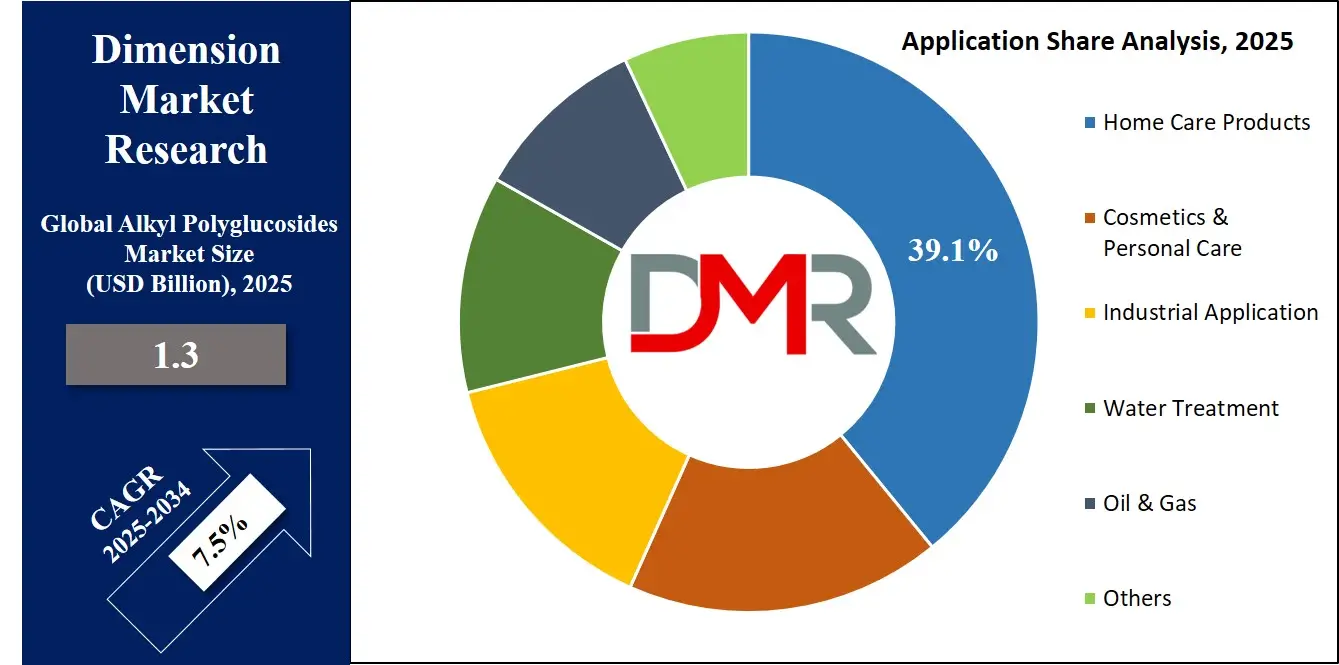
APGs are ideal for these applications because they are mild, biodegradable, and derived from natural sources like sugar and fatty alcohols. Their strong cleaning power without harsh effects makes them a top choice for home care brands aiming to offer safe and sustainable products. The rise of health-conscious households, combined with supportive labeling and marketing of plant-based cleaners, continues to strengthen the role of home care in boosting overall market demand for APG-based formulations.
Water treatment applications are showing significant growth over the forecast period in the Alkyl Polyglucosides market due to the increasing need for safe, biodegradable, and low-toxicity surfactants in industrial and municipal systems. As water quality becomes a global concern, industries are shifting to greener chemical options that do not harm aquatic environments.
APGs are used in water treatment processes for their ability to reduce surface tension and aid in cleaning, dispersing, or emulsifying contaminants. Their compatibility with both hard and soft water systems makes them effective across varied treatment conditions. Countries with growing industrial activity and stricter environmental laws are adopting APG-based solutions in wastewater management. This increasing focus on sustainable water treatment practices is helping drive the use of Alkyl Polyglucosides in this critical application area.
The Alkyl Polyglucosides Market Report is segmented on the basis of the following:
By Raw Material
By Application
- Cosmetics & Personal Care
- Home Care Products
- Industrial Application
- Water Treatment
- Oil & Gas
- Others
Regional Analysis
Leading Region in the Alkyl Polyglucosides Market
The Asia Pacific is expected to lead the Alkyl Polyglucosides market in 2025, with a regional share of 35.8%, driven by the rising demand for eco-friendly and biodegradable surfactants across various industries. Countries like China, India, Japan, and South Korea are witnessing strong growth in personal care, home care, and industrial cleaning sectors, where APGs are increasingly used as a safer alternative to traditional chemical surfactants.
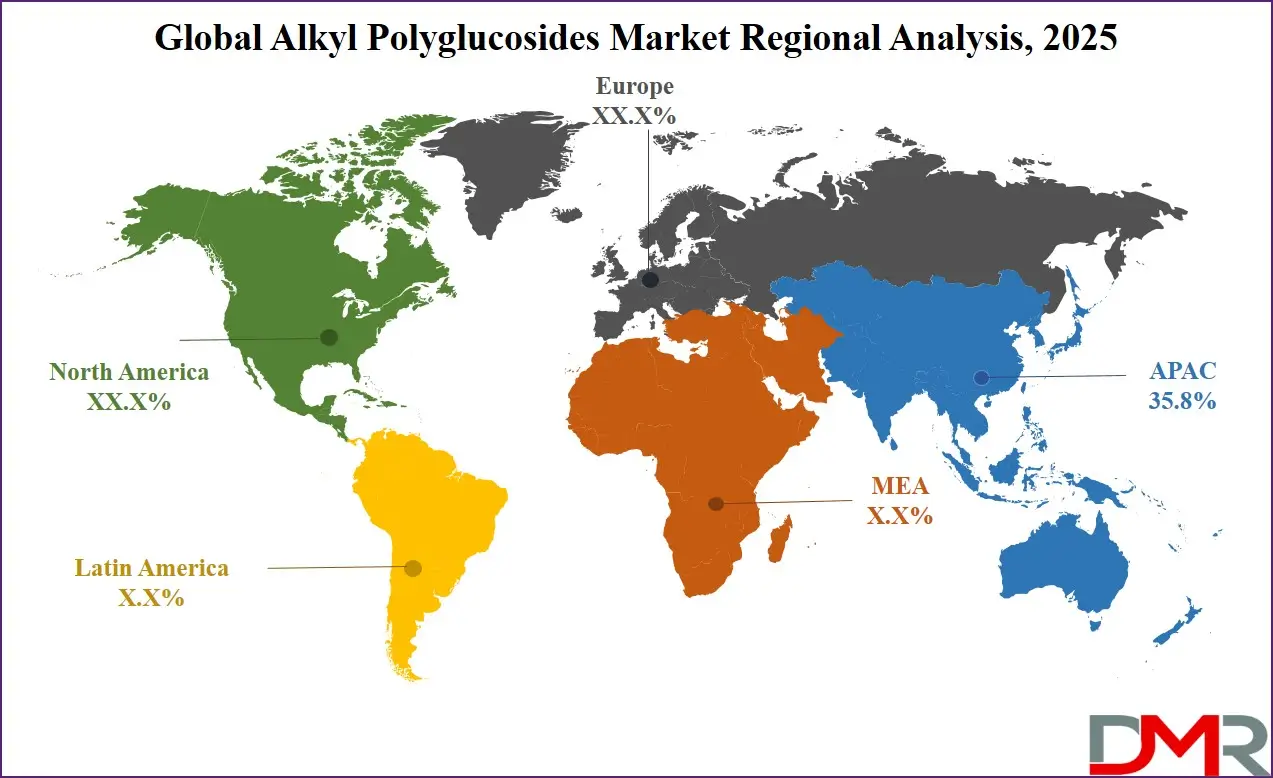
Growing awareness about sustainable ingredients and stricter regulations around chemical use are also pushing manufacturers in the region to adopt green chemistry practices. The rapid expansion of urban populations and rising disposable incomes are fueling demand for mild and natural products in everyday use. In addition, regional manufacturing capabilities and cost-effective raw material sourcing give Asia Pacific a competitive advantage in scaling APG production. While 2025 is still ongoing, current trends and ongoing product developments clearly show that Asia Pacific continues to strengthen its position as a key contributor to the global Alkyl Polyglucosides market.
Fastest Growing Region in the Alkyl Polyglucosides Market
Latin America is expected to exhibit significant growth over the forecast period in the Alkyl Polyglucosides market, driven by the rising demand for natural surfactants in household care and personal care products. Countries like Brazil and Mexico are seeing a shift toward eco-friendly and biodegradable ingredients as consumers become more aware of product safety and environmental impact. The region’s growing urban population and expanding middle class are also contributing to the increased use of green cleaning agents and mild personal care items. Local manufacturers are gradually adopting sustainable surfactant technologies, and with supportive regulations and increased investments, Latin America is expected to become a significant market for Alkyl Polyglucosides in the near future.
By Region
North America
Europe
- Germany
- The U.K.
- France
- Italy
- Russia
- Spain
- Benelux
- Nordic
- Rest of Europe
Asia-Pacific
- China
- Japan
- South Korea
- India
- ANZ
- ASEAN
- Rest of Asia-Pacific
Latin America
- Brazil
- Mexico
- Argentina
- Colombia
- Rest of Latin America
Middle East & Africa
- Saudi Arabia
- UAE
- South Africa
- Israel
- Egypt
- Rest of MEA
Competitive Landscape
The Alkyl Polyglucosides market is becoming more competitive as demand grows for eco-friendly and safe cleaning ingredients. Many companies are entering the space, offering a wide range of APG-based products for personal care, household cleaning, and industrial use. Manufacturers are focusing on improving product quality, expanding their production capacity, and developing customized formulations for specific needs.
Innovation is a key driver, with players investing in research to create more effective, stable, and biodegradable solutions. The market is also seeing growth across different regions, leading to more partnerships and distribution networks. As environmental awareness rises and regulations tighten, companies are competing not just on price, but also on sustainability, performance, and the ability to meet clean-label demands.
Some of the prominent players in the global Alkyl Polyglucosides are
- BASF SE
- Clariant AG
- Croda International plc
- Dow Inc.
- Fenchem
- Nouryon
- Seppic (Air Liquide)
- Kao Corporation
- LG Household & Health Care Ltd
- Shanghai Fine Chemical Co., Ltd.
- Yangzhou Chenhua New Material Co., Ltd.
- Jiangsu WanQi Biotechnology
- Yixing Jinlan Chemical
- Haining Yuanyuan Biotechnology
- Spec Chem Industry Inc.
- Pilot Chemical Corp.
- Huntsman Corporation
- AkzoNobel N.V.
- Galaxy Surfactants Ltd.
- Stepan Company
- Other Key Players
Recent Developments
- In October 2024, BASF introduced Sokalan Eco GP 790 L, a new anti-redeposition laundry polymer designed to support sustainability goals. With 79% biobased content and being readily biodegradable, it offers a greener alternative comparable to carboxymethyl cellulose. Sokalan Eco GP 790 L allows formulators to boost renewable carbon content in detergents, supporting circularity and lowering emissions. Despite its eco-friendly profile, it matches the performance of synthetic options like acrylic polymers. Both visual and quantitative tests confirm its effectiveness, making it a strong, sustainable choice for modern formulations.
- Mar 2023: Dow launched EcoSense GL-60 HA Surfactant, which is an alkyl polyglucosides product.
- Sep 2023: Croda International Plc introduced a self-cleaning fabric conditioner containing APG, targeting consumers wanting easy-care textiles.
Report Details
| Report Characteristics |
| Market Size (2025) |
USD 1.3 Bn |
| Forecast Value (2034) |
USD 2.5 Bn |
| CAGR (2025–2034) |
7.5% |
| Historical Data |
2019 – 2024 |
| The US Market Size (2025) |
USD 300 Mn |
| Forecast Data |
2025 – 2033 |
| Base Year |
2024 |
| Estimate Year |
2025 |
| Report Coverage |
Market Revenue Estimation, Market Dynamics, Competitive Landscape, Growth Factors, etc. |
| Segments Covered |
By Raw Material (Glucose and Fatty Alcohol), By Application (Cosmetics & Personal Care, Home Care Products, Industrial Application, Water Treatment, Oil & Gas, and Others) |
| Regional Coverage |
North America – US, Canada; Europe – Germany, UK, France, Russia, Spain, Italy, Benelux, Nordic, Rest of Europe; Asia-Pacific – China, Japan, South Korea, India, ANZ, ASEAN, Rest of APAC; Latin America – Brazil, Mexico, Argentina, Colombia, Rest of Latin America; Middle East & Africa – Saudi Arabia, UAE, South Africa, Turkey, Egypt, Israel, Rest of MEA |
| Prominent Players |
BASF SE, Clariant AG, Croda International plc, Dow Inc., Fenchem, Nouryon, Seppic (Air Liquide), Kao Corporation, LG Household & Health Care Ltd, Shanghai Fine Chemical Co., Ltd., Yangzhou Chenhua New Material Co., Ltd., Jiangsu WanQi Biotechnology, Yixing Jinlan Chemical, Haining Yuanyuan Biotechnology, Spec Chem Industry Inc., Pilot Chemical Corp., Huntsman Corporation, AkzoNobel N.V., Galaxy Surfactants Ltd., Stepan Company, and Other Key Players |
| Purchase Options |
We have three licenses to opt for: Single User License (Limited to 1 user), Multi-User License (Up to 5 Users), and Corporate Use License (Unlimited User) along with free report customization equivalent to 0 analyst working days, 3 analysts working days, and 5 analysts working days respectively. |
Frequently Asked Questions
The Global Alkyl Polyglucosides Market size is estimated to have a value of USD 1,207.0 million in 2024
and is expected to reach USD 2,250.3 million by the end of 2033.
Asia Pacific is expected to have the largest market share in the Global Alkyl Polyglucosides Market with a
share of about 34.1% in 2024.
Some of the major key players in the Global Alkyl Polyglucosides Market are APL, Clariant, Croda
International Plc, and many others.
The Alkyl Polyglucosides market is growing at a CAGR of 7.2 % over the forecasted period.